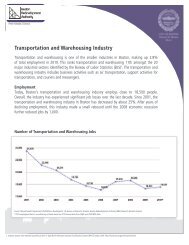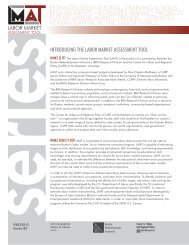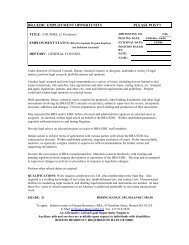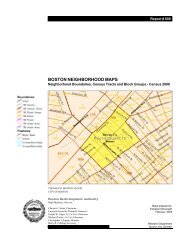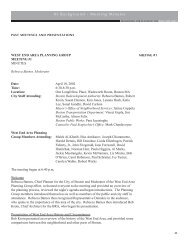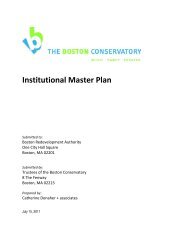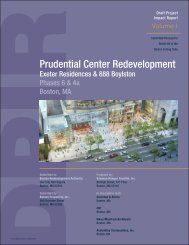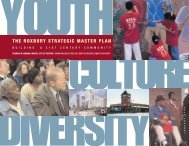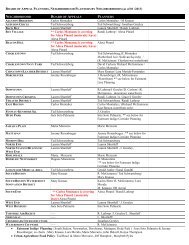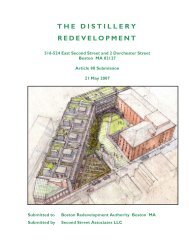point cover jan 13 - Boston Redevelopment Authority
point cover jan 13 - Boston Redevelopment Authority
point cover jan 13 - Boston Redevelopment Authority
Create successful ePaper yourself
Turn your PDF publications into a flip-book with our unique Google optimized e-Paper software.
\\MABOS\projects\1<strong>13</strong>81.00\reports\Article80\<br />
Expanded_PNF\04_Environmental_FINAL.do<br />
c<br />
Vanasse Hangen Brustlin, Inc.<br />
The Point, <strong>Boston</strong><br />
No-Build Conditions – includes existing buildings on and around the Project Site as well as planned<br />
buildings within the study locus; and<br />
Build Conditions – includes the proposed building design within the existing site surroundings and any<br />
planned buildings within the project area.<br />
The scale model was equipped with specifically designed wind speed sensors that were connected to the<br />
wind tunnel’s data acquisition system to record the mean and fluctuating components of wind speed at a fullscale<br />
height of about five feet above grade in pedestrian areas throughout the study area. Study locations<br />
were selected by RWDI based on their extensive experience in modeling pedestrian level wind conditions in<br />
<strong>Boston</strong>. These locations were reviewed by the BRA and updated per their comments prior to testing. Specific<br />
study locations were selected to adequately model conditions at along the public pedestrian ways around the<br />
site, adjacent abutting properties and at key building roof locations. The horizontal extent of the study area<br />
was selected to capture any locations likely to be affected by the Project. This methodology was confirmed by<br />
comparing the modeled conditions at the perimeter of the study area under the No-Build and Build<br />
Conditions. See Appendix C for further information.<br />
Wind speeds were measured for 36 wind directions, in 10 degree increments, starting from true north. The<br />
measurements at each sensor location were recorded in the form of ratios of local mean and gust speeds to<br />
the reference wind speed in the free stream above the model. The results were then combined with long-term<br />
meteorological data, recorded during the years 1973 to 2011 at <strong>Boston</strong>’s Logan International Airport, in order<br />
to predict full scale wind conditions. The analysis was performed separately for each of the four seasons and<br />
for the entire year. The results of the wind tunnel study were compared to the BRA recommended criteria for<br />
evaluating pedestrian level winds.<br />
This study involved state-of-the-art measurements and analysis techniques to predict wind conditions at the<br />
study site. However, some uncertainty remains in predicting wind comfort, and this must be kept in mind.<br />
For example, the sensation of comfort among individuals can be quite variable. The comfort limits used in<br />
this report represent an average for the total population. Also, unforeseen changes in the project area, such as<br />
the construction or removal of buildings, can affect the conditions experiences at the Project Site. Finally, the<br />
predictions of wind speeds are necessarily a statistical procedure. The wind speeds reported are for the<br />
frequency or occurrence stated (on percent of the time). Higher wind speeds may occur but on a less frequent<br />
basis.<br />
<br />
Pedestrian Wind Comfort Criteria<br />
The BRA has adopted two standards for assessing the relative wind comfort of pedestrians. First, the BRA<br />
wind design guidance criterion states that an effective gust velocity (hourly mean wind speed +1.5 times the<br />
root-mean-square wind speed) of 31 miles per hour (mph) should not be exceeded more than one percent of<br />
the time. The second set of criteria used by the BRA to determine the acceptability of specific location is based<br />
on the work of Melbourne. This set of criteria is used to determine the relative level of pedestrian wind<br />
comfort for activities such as sitting, standing or walking. The criteria are expressed in terms of benchmarks<br />
for the 1-hour mean wind speed exceeded one percent of the time (i.e., the 99 th percentile mean wind speed).<br />
They are as follows in Table 4-1.<br />
4-4 Environmental Protection



